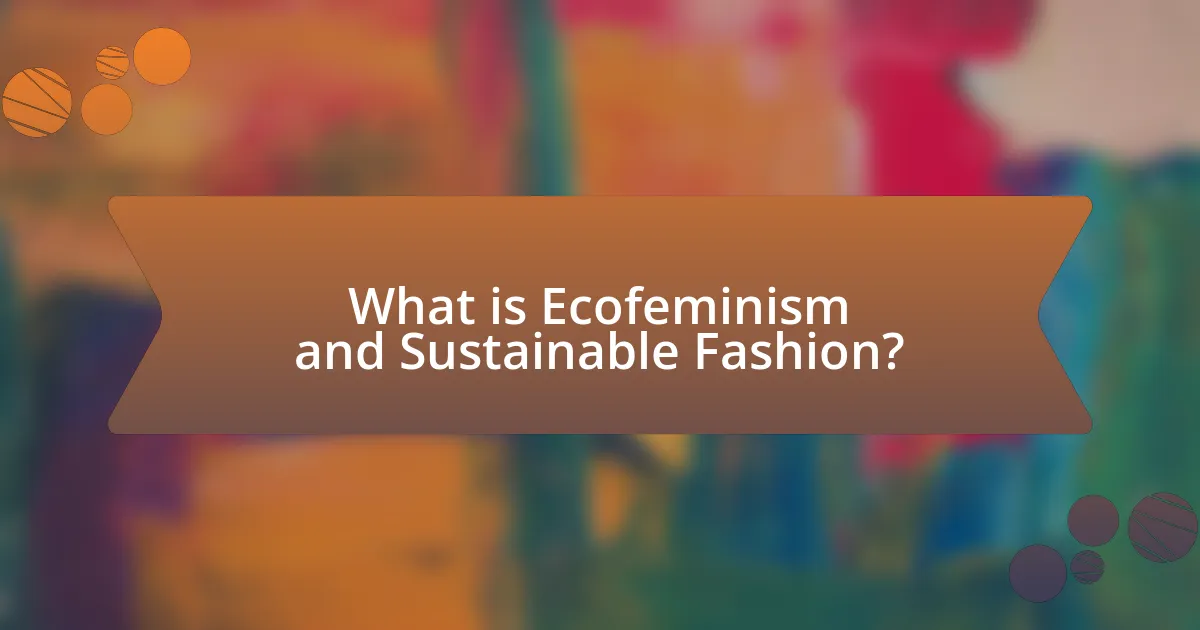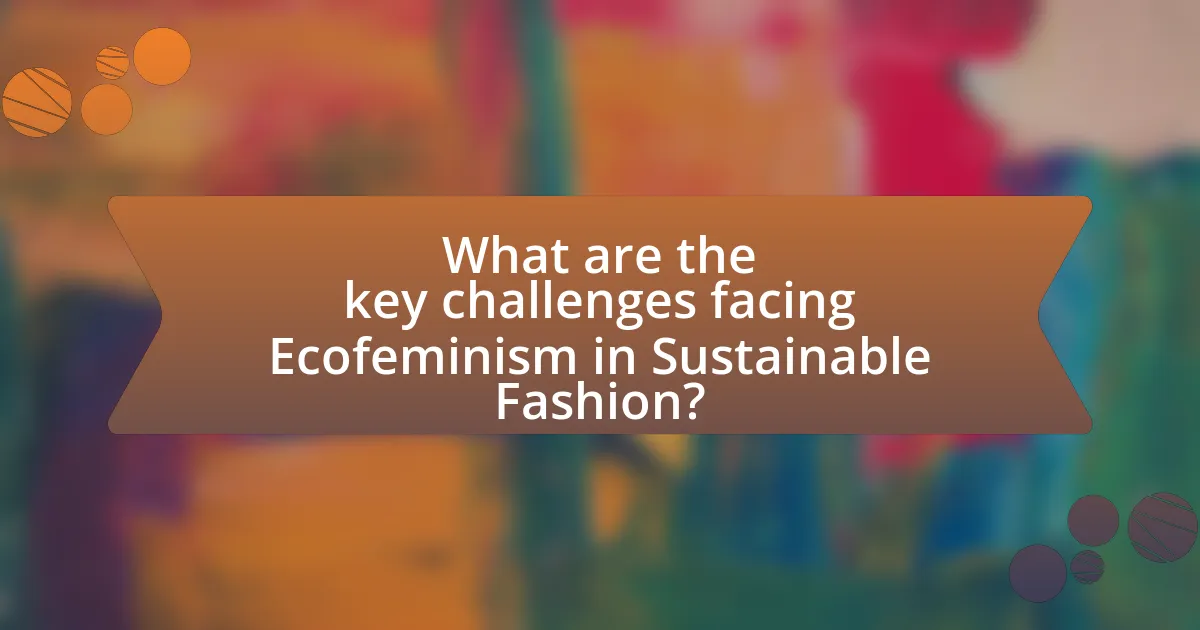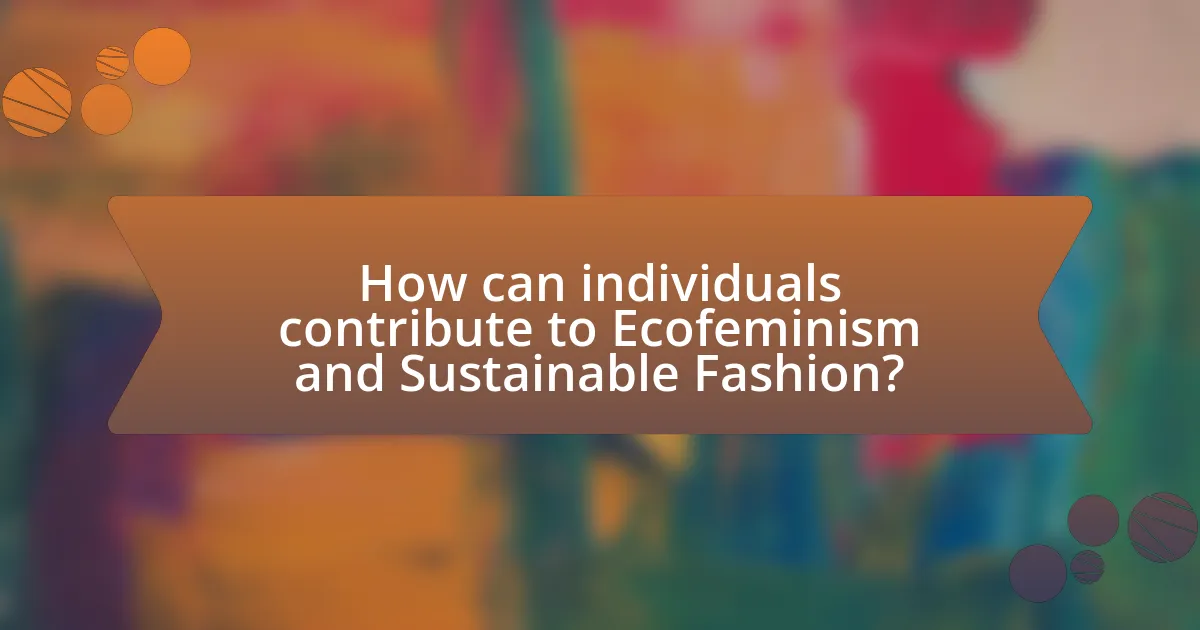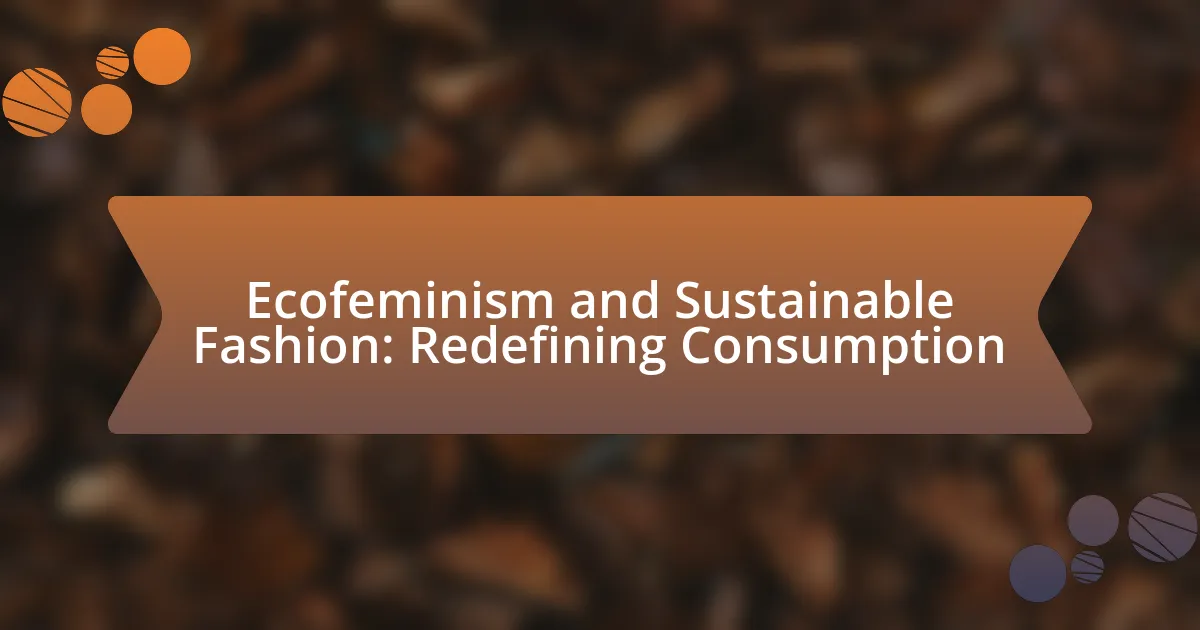Ecofeminism and sustainable fashion are interconnected movements that address the exploitation of nature and the oppression of women, advocating for environmental sustainability and social justice. The article explores how ecofeminism critiques patriarchal structures contributing to ecological degradation while promoting ethical production practices in the fashion industry. It highlights the importance of redefining consumption patterns to prioritize sustainability and ethical labor, examines the environmental impacts of traditional fashion consumption, and discusses the role of consumer behavior and marketing in shaping attitudes towards sustainable practices. Additionally, it outlines practical steps individuals can take to support ecofeminism and sustainable fashion, along with successful examples of brands that embody these principles.

What is Ecofeminism and Sustainable Fashion?
Ecofeminism is a philosophical and social movement that connects the exploitation of nature with the oppression of women, advocating for a holistic approach to environmentalism that considers gender equality. Sustainable fashion refers to clothing and accessories produced in environmentally friendly ways, emphasizing ethical labor practices, resource conservation, and minimal environmental impact. The intersection of ecofeminism and sustainable fashion highlights the importance of addressing both ecological sustainability and social justice in the fashion industry, promoting practices that empower marginalized communities while protecting the environment. This connection is supported by studies showing that sustainable fashion initiatives can lead to reduced waste and improved labor conditions, thereby aligning with ecofeminist principles.
How do Ecofeminism and Sustainable Fashion intersect?
Ecofeminism and sustainable fashion intersect through their shared emphasis on the interconnectedness of environmental sustainability and social justice, particularly regarding the exploitation of both nature and marginalized communities. Ecofeminism critiques the patriarchal structures that contribute to environmental degradation and advocates for a holistic approach to ecological issues, which aligns with sustainable fashion’s goal of promoting ethical production practices and reducing waste. For instance, sustainable fashion often incorporates eco-friendly materials and fair labor practices, reflecting ecofeminist principles that prioritize the well-being of both the planet and people. This intersection is evident in movements that advocate for transparency in supply chains and the empowerment of women in the fashion industry, highlighting the importance of ethical consumption as a means to challenge systemic inequalities.
What are the core principles of Ecofeminism?
The core principles of Ecofeminism include the interconnectedness of the exploitation of women and nature, the critique of patriarchy, and the advocacy for ecological sustainability. Ecofeminism posits that both women and the environment are marginalized by patriarchal structures, leading to a dual oppression that must be addressed simultaneously. This perspective emphasizes the importance of recognizing the value of both feminine and ecological wisdom in creating sustainable practices. Furthermore, Ecofeminism promotes social justice, advocating for the rights of marginalized communities while striving for environmental protection. These principles are supported by various studies that highlight the links between gender inequality and environmental degradation, illustrating how addressing one can lead to improvements in the other.
How does Sustainable Fashion embody these principles?
Sustainable fashion embodies ecofeminist principles by prioritizing ethical production, environmental stewardship, and social justice. It emphasizes the use of eco-friendly materials, such as organic cotton and recycled fabrics, which reduce environmental impact and promote biodiversity. Additionally, sustainable fashion advocates for fair labor practices, ensuring that workers receive fair wages and safe working conditions, thereby addressing social inequalities. Research indicates that the fashion industry is responsible for 10% of global carbon emissions, highlighting the urgent need for sustainable practices to mitigate climate change. By integrating these principles, sustainable fashion not only seeks to minimize harm to the planet but also aims to empower marginalized communities, aligning with ecofeminist values.
Why is redefining consumption important in this context?
Redefining consumption is important in the context of ecofeminism and sustainable fashion because it challenges the traditional notions of consumerism that contribute to environmental degradation and social inequality. This shift encourages individuals and communities to prioritize ethical sourcing, sustainable materials, and equitable labor practices, which are essential for fostering a more just and sustainable society. Research indicates that the fashion industry is responsible for significant environmental harm, including 10% of global carbon emissions and substantial water pollution, highlighting the urgent need for a transformation in consumption patterns to mitigate these impacts. By redefining consumption, ecofeminism advocates for a holistic approach that integrates ecological sustainability with social justice, ultimately promoting a more responsible and conscious way of engaging with fashion.
What are the environmental impacts of traditional fashion consumption?
Traditional fashion consumption significantly contributes to environmental degradation through high resource use, pollution, and waste generation. The fashion industry is responsible for approximately 10% of global carbon emissions, primarily due to energy-intensive production processes and transportation. Additionally, it consumes vast amounts of water; for instance, producing a single cotton t-shirt requires about 2,700 liters of water, enough for one person to drink for two and a half years. Furthermore, traditional fashion practices lead to substantial textile waste, with around 92 million tons of textiles discarded annually, much of which ends up in landfills, contributing to soil and water contamination. These impacts highlight the urgent need for sustainable practices in the fashion industry to mitigate environmental harm.
How does Ecofeminism propose to change consumption patterns?
Ecofeminism proposes to change consumption patterns by advocating for a shift towards sustainable and ethical practices that prioritize environmental health and social justice. This approach emphasizes the interconnectedness of ecological degradation and the oppression of marginalized groups, suggesting that consumption should reflect values of care, responsibility, and respect for both nature and human rights. Ecofeminists argue for reducing consumption overall, promoting local and organic products, and supporting fair trade to ensure that both the environment and communities are protected. Research indicates that adopting these practices can lead to a significant reduction in ecological footprints and promote a more equitable distribution of resources.

What are the key challenges facing Ecofeminism in Sustainable Fashion?
The key challenges facing Ecofeminism in Sustainable Fashion include the intersection of gender inequality, environmental degradation, and consumerism. Ecofeminism advocates for the connection between the exploitation of women and nature, yet the fashion industry often perpetuates these issues through unsustainable practices and labor exploitation. For instance, women, who make up a significant portion of garment workers, frequently face poor working conditions and low wages, highlighting the gender disparity in the industry. Additionally, the fast fashion model promotes overconsumption, which contradicts Ecofeminist principles of sustainability and respect for the environment. This creates a complex landscape where Ecofeminism must navigate both social justice and ecological concerns, making it challenging to implement effective sustainable practices within the fashion sector.
What societal attitudes hinder the adoption of sustainable practices?
Societal attitudes that hinder the adoption of sustainable practices include consumerism, skepticism towards climate change, and a preference for convenience over sustainability. Consumerism drives individuals to prioritize immediate gratification and material accumulation, often at the expense of environmental considerations. Skepticism towards climate change leads to resistance against adopting practices perceived as unnecessary or burdensome, undermining collective action for sustainability. Additionally, the preference for convenience results in the continued use of single-use products and fast fashion, which are detrimental to sustainable practices. These attitudes collectively create barriers to the widespread implementation of eco-friendly alternatives and sustainable consumption habits.
How do consumer behaviors affect sustainable fashion initiatives?
Consumer behaviors significantly influence sustainable fashion initiatives by driving demand for eco-friendly products and practices. When consumers prioritize sustainability, brands are compelled to adopt environmentally responsible methods, such as using organic materials and ethical labor practices. A study by McKinsey & Company found that 67% of consumers consider the use of sustainable materials important when making fashion purchases, indicating a clear market preference for sustainable options. This consumer demand encourages brands to innovate and invest in sustainable technologies, ultimately shaping the fashion industry’s approach to environmental responsibility.
What role does marketing play in shaping these attitudes?
Marketing plays a crucial role in shaping attitudes towards ecofeminism and sustainable fashion by influencing consumer perceptions and behaviors. Through targeted campaigns, marketing communicates the values of sustainability and ethical consumption, thereby fostering a connection between consumers and eco-friendly brands. For instance, studies show that brands that emphasize their commitment to environmental and social responsibility can enhance consumer loyalty and preference, as seen in the rise of brands like Patagonia, which effectively markets its environmental initiatives. This strategic messaging not only raises awareness but also encourages consumers to adopt more sustainable practices, aligning their purchasing decisions with their values.
What economic factors influence sustainable fashion?
Economic factors influencing sustainable fashion include consumer demand for ethical products, production costs associated with sustainable materials, and market competition. Consumer demand drives brands to adopt sustainable practices, as evidenced by a 2021 McKinsey report indicating that 67% of consumers consider sustainability when making a purchase. Production costs are often higher for sustainable materials, impacting pricing strategies; for instance, organic cotton can cost up to 50% more than conventional cotton. Additionally, market competition compels brands to innovate and differentiate themselves through sustainability, as seen in the rise of eco-conscious brands like Patagonia and Everlane, which have successfully integrated sustainability into their business models.
How do production costs impact the viability of sustainable fashion brands?
Production costs significantly impact the viability of sustainable fashion brands by influencing pricing strategies and market competitiveness. High production costs associated with sustainable materials and ethical labor practices can lead to higher retail prices, which may limit consumer accessibility and demand. For instance, a study by the Global Fashion Agenda indicates that sustainable materials can cost up to 30% more than conventional options, affecting profit margins. Consequently, brands must balance sustainability with affordability to attract a broader customer base while maintaining their ethical commitments.
What are the financial benefits of adopting sustainable practices?
Adopting sustainable practices leads to significant financial benefits, including cost savings, increased efficiency, and enhanced brand reputation. Companies that implement sustainable practices often reduce operational costs through energy efficiency, waste reduction, and resource conservation. For instance, a study by the Carbon Trust found that businesses can save up to 20% on energy bills by adopting energy-efficient technologies. Additionally, sustainable practices can attract environmentally conscious consumers, leading to increased sales and customer loyalty. According to Nielsen, 66% of global consumers are willing to pay more for sustainable brands, which can enhance a company’s market position and profitability.

How can individuals contribute to Ecofeminism and Sustainable Fashion?
Individuals can contribute to Ecofeminism and Sustainable Fashion by making conscious choices in their consumption habits. This includes opting for ethically produced clothing, supporting brands that prioritize sustainability and fair labor practices, and reducing overall consumption by embracing minimalism. Research indicates that the fashion industry is responsible for 10% of global carbon emissions, highlighting the importance of sustainable practices. By participating in clothing swaps, buying second-hand, and advocating for policies that promote environmental justice, individuals can further align their actions with ecofeminist principles, which emphasize the interconnectedness of social and environmental issues.
What practical steps can consumers take to support sustainable fashion?
Consumers can support sustainable fashion by choosing to buy from brands that prioritize ethical production practices and use eco-friendly materials. This includes researching companies to ensure they have transparent supply chains and sustainable sourcing policies. Additionally, consumers can reduce their fashion footprint by purchasing second-hand clothing, which extends the life cycle of garments and minimizes waste. According to the Ellen MacArthur Foundation, extending the life of clothes by just nine months can reduce carbon, water, and waste footprints by around 20-30%. Furthermore, consumers can practice mindful consumption by buying fewer, higher-quality items that are designed to last, rather than fast fashion pieces that contribute to environmental degradation. Engaging in clothing swaps and supporting local artisans also promotes sustainable practices within the fashion industry.
How can individuals make informed purchasing decisions?
Individuals can make informed purchasing decisions by researching product origins, understanding sustainability practices, and evaluating brand transparency. Researching product origins involves checking where materials are sourced and how they are produced, which helps consumers assess environmental impact. Understanding sustainability practices includes looking for certifications like Fair Trade or organic labels, indicating ethical production methods. Evaluating brand transparency means examining how openly brands communicate their supply chain practices and labor conditions, which can be verified through third-party reports or consumer reviews. This approach enables individuals to align their purchases with ecofeminist values and sustainable fashion principles, ultimately fostering responsible consumption.
What role does second-hand shopping play in sustainable consumption?
Second-hand shopping significantly contributes to sustainable consumption by extending the lifecycle of products and reducing waste. This practice minimizes the demand for new goods, which in turn decreases resource extraction, energy consumption, and carbon emissions associated with manufacturing. According to a study by the Ellen MacArthur Foundation, extending the life of clothing by just nine months can reduce carbon, water, and waste footprints by 20-30%. Thus, second-hand shopping not only promotes environmental sustainability but also encourages a shift towards a circular economy, where products are reused and recycled rather than discarded.
What are some successful examples of Ecofeminism in action within the fashion industry?
Successful examples of Ecofeminism in action within the fashion industry include brands like Stella McCartney and Reformation, which prioritize sustainable practices and ethical labor. Stella McCartney has been a pioneer in using eco-friendly materials, such as organic cotton and recycled polyester, while advocating for animal rights by not using leather or fur. Reformation focuses on transparency in its supply chain and has implemented a carbon footprint calculator for its products, allowing consumers to understand the environmental impact of their purchases. Both brands exemplify the principles of Ecofeminism by promoting environmental sustainability and social justice within the fashion industry.
Which brands exemplify the principles of Ecofeminism and sustainability?
Brands that exemplify the principles of Ecofeminism and sustainability include Patagonia, Eileen Fisher, and Reformation. Patagonia is known for its commitment to environmental activism and ethical sourcing, using recycled materials and promoting fair labor practices. Eileen Fisher focuses on sustainable materials and has initiatives aimed at reducing waste through recycling and take-back programs. Reformation emphasizes eco-friendly practices in its production processes and transparency in its supply chain, aligning with Ecofeminist values of social and environmental justice. These brands demonstrate a commitment to both ecological sustainability and the empowerment of women, key tenets of Ecofeminism.
How have these brands influenced consumer perceptions?
Brands focused on ecofeminism and sustainable fashion have significantly influenced consumer perceptions by promoting ethical consumption and environmental awareness. These brands, such as Stella McCartney and Patagonia, have positioned themselves as leaders in sustainability, effectively reshaping consumer expectations regarding the environmental impact of their purchases. For instance, Patagonia’s “Don’t Buy This Jacket” campaign encouraged consumers to consider the ecological footprint of their clothing, leading to increased awareness about overconsumption. Research indicates that 66% of consumers are willing to pay more for sustainable brands, highlighting a shift in consumer values towards sustainability. This shift reflects a growing recognition of the interconnectedness of gender, environment, and consumption, as these brands advocate for both social justice and ecological responsibility.
What are the future trends in Ecofeminism and Sustainable Fashion?
Future trends in Ecofeminism and Sustainable Fashion include a growing emphasis on circular economy practices, increased collaboration between brands and grassroots movements, and a focus on intersectionality in sustainability efforts. The circular economy approach aims to minimize waste and promote the reuse of materials, which aligns with ecofeminist principles of valuing both nature and marginalized communities. Collaborative initiatives, such as partnerships between fashion brands and ecofeminist organizations, are becoming more common, fostering a shared commitment to ethical production and environmental justice. Additionally, the integration of intersectionality highlights the importance of addressing social inequalities alongside environmental concerns, ensuring that sustainable fashion practices are inclusive and equitable. These trends are supported by research indicating that consumers increasingly demand transparency and ethical practices from brands, driving the industry towards more responsible consumption patterns.
How might technology shape the future of sustainable fashion?
Technology will significantly shape the future of sustainable fashion by enabling innovative materials, enhancing supply chain transparency, and promoting circular economy practices. Advanced technologies such as 3D printing and biofabrication allow for the creation of sustainable textiles from organic materials, reducing reliance on harmful synthetic fibers. Additionally, blockchain technology can provide traceability in the supply chain, ensuring ethical sourcing and production practices, which is crucial for consumer trust. According to a report by McKinsey & Company, the integration of digital technologies in fashion can reduce waste by up to 30%, highlighting the potential for technology to drive sustainability in the industry.
What emerging movements align with Ecofeminism in fashion?
Emerging movements that align with Ecofeminism in fashion include slow fashion, circular fashion, and ethical fashion. Slow fashion emphasizes quality over quantity, advocating for sustainable production methods and fair labor practices, which resonate with Ecofeminist principles of environmental and social justice. Circular fashion promotes the idea of reusing and recycling materials to minimize waste, aligning with Ecofeminism’s focus on nurturing the planet. Ethical fashion prioritizes transparency and accountability in the supply chain, reflecting Ecofeminism’s commitment to equity and sustainability. These movements collectively challenge the fast fashion industry and advocate for a more responsible approach to consumption.
What are the best practices for embracing Ecofeminism in personal fashion choices?
To embrace Ecofeminism in personal fashion choices, individuals should prioritize sustainable materials, support ethical brands, and practice mindful consumption. Sustainable materials, such as organic cotton and recycled fabrics, reduce environmental harm and promote ecological balance. Supporting ethical brands that prioritize fair labor practices aligns with Ecofeminist values by advocating for social justice and the rights of marginalized communities. Mindful consumption involves purchasing only what is necessary, opting for second-hand clothing, and engaging in clothing swaps, which minimizes waste and promotes a circular economy. These practices collectively contribute to a more equitable and sustainable fashion industry, reflecting the core principles of Ecofeminism.
